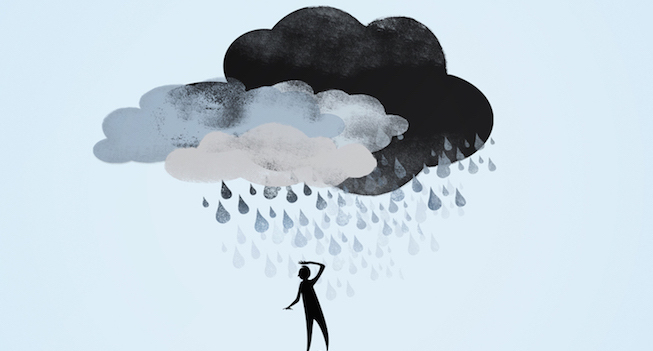Human beings are social species. We naturally interact and bond with other people. According to evolutionary theory, loneliness has played an important role in the survival of humans because connecting with others increases one’s chances of living (Cacioppo, Hawkley, et al., 2006). Still today, it seems that we feel lonely whenever we are prevented from opportunities to develop close relationships and to interact with other people. Loneliness is not conceptualized as a disorder, but its repercussions are well-documented. Science tells us that when people’s social needs are not fulfilled, their mental and physical health may be negatively affected.
What is loneliness?
It is important to distinguish loneliness from social isolation. Loneliness is related to a negative feeling. It reflects a subjective disequilibrium, or dissatisfaction, with the discrepancy between actual and desired social interactions (Ernst & Cacioppo, 1999; Peplau & Perlman, 1982). Loneliness is often considered as the subjective perception of social isolation (Holt-Lunstad, Smith, Baker, Harris, & Stephenson, 2015). Social isolation reflects an objective state in which people do not have opportunities for social interactions. For instance, isolated people may live alone or have no opportunity to regularly meet friends and family. Being isolated often leads to the emergence of loneliness (Yildirim & Kocabiyik, 2010). However, not all isolated people feel lonely. Some people prefer to live alone and enjoy solitary activities. In contrast, some people feel lonely while surrounded by family and friends. Interestingly, loneliness and social isolation are only weakly associated (Coyle & Dugan, 2012), which further highlights the importance of considering them separately (Holt-Lunstad et al., 2015).
“some people feel lonely while surrounded by family and friends”
Loneliness has most commonly been studied among elderly adults. In this population, approximately one in ten people report that they often or always feel lonely (Victor et al., 2000). The prevalence of loneliness has remained relatively stable for several decades (Victor et al., 2002), indicating that loneliness is not a new phenomenon among older adults. But why are so many older adults lonely?
Significant life transitions during old age can lead to social isolation, which puts a person at risk of developing persistent feelings of loneliness (Victor et al., 2002). For example, older age often coincides with the death of a close relative, such as a spouse or sibling, which can leave a void in a person’s life. People may also retire from employment in older age and find themselves without a daily occupation or without the daily interactions that they used to have at their workplace.
Importantly, researchers have uncovered a high prevalence of loneliness among young adults as well, highlighting that it is not just a condition suffered by the elderly. In a recent paper researchers showed that neuroticism, depression, anxiety, bullying and social isolation during childhood could all predict loneliness at age 18. Among the young adults in this study loneliness occurred indiscriminately across genders and socioeconomic strata (Matthews et al., 2018).
What are the outcomes of loneliness and social isolation?
Despite being two distinct constructs, both loneliness and social isolation share overlap with similar physical health problems (e.g., higher blood pressure and poorer immune functioning; Grant et al., 2009; Hawkley & Cacioppo, 2010). A meta-analysis showed that both loneliness and social isolation could significantly predict the likelihood of mortality in older adults (Holt-Lundstat and Smith, 2015), although the mechanisms by which they lead to this outcome may differ.
Loneliness and social isolation have also been found to be associated with different health outcomes (Coyle & Dugan, 2012). For example, lonely people experience more negative affect, and are more likely to suffer from mental health issues, such as depression and dementia (Cacioppo et al., 2006; Holwerda et al., 2014; Matthews et al., 2018). In contrast, social isolation appears to relate more to unhealthy life habits, such as a sedentary lifestyle.
“lonely people experience more negative affect, and are more likely to suffer from mental health issues, such as depression and dementia”

What are the causes of loneliness?
A multitude of reasons, including important life transitions, may induce social isolation. However, understanding the factors that cause loneliness is more complex, given that it is a subjective concept, based on people’s perception of their own social life.
Several factors contributing to loneliness have been identified, and these include both environmental, such as sociodemographic factors and perceptions, and genetic factors. For instance, loneliness is more common in women, in people with low levels of education and income, and in people who previously occupied physical jobs such as farm or factory work (Victor et al., 2002). The most common reasons mentioned when asking elderly people why they feel lonely are illness, death of a spouse, and lack of friends (Victor et al., 2002). Also, people who think that their life is meaningless and that their relatives are absent are more likely to feel lonely.
Genetic differences may also explain why some people are more at risk of feeling lonely than others. The heritability of loneliness is estimated at around 50% (Goossens et al., 2015) . This means that approximately half of the variation in the population can be explained by genetic differences between people (see our “H” post for a more in-depth description of Heritability). Moreover, almost half of this heritability is explained by common genetic variations in the population (Gao et al., 2017).
“Genetic differences may also explain why some people are more at risk of feeling lonely than others”
We are still far from identifying the specific genetic markers associated with loneliness. Nonetheless, we are aware of several environmental risk factors of loneliness, and future research should aim to examine whether the risk for loneliness is exacerbated by these environmental factors in people who are already at risk genetically. Furthermore, environmental risk factors that have been identified so far should be targeted in interventions to reduce loneliness. Such interventions are important given that loneliness is associated with several mental health issues and early mortality.
References
- Cacioppo, J. T., Hawkley, L. C., Ernst, J. M., Burleson, M., Berntson, G. G., Nouriani, B., & Spiegel, D. (2006). Loneliness within a nomological net: An evolutionary perspective. Journal of Research in Personality, 40, 1054–1085. http://doi.org/10.1016/j.jrp.2005.11.007
- Cacioppo, J. T., Hughes, M. E., Waite, L. J., Hawkley, L. C., & Thisted, R. A. (2006). Loneliness as a specific risk factor for depressive symptoms: Cross-sectional and longitudinal analyses. Psychology and Aging, 21, 140–151. http://doi.org/10.1037/0882-7974.21.1.140
- Coyle, C. E., & Dugan, E. (2012). Social Isolation, Loneliness and Health Among Older Adults. Journal of Aging and Health, 24(8), 1346–1363. http://doi.org/10.1177/0898264312460275
- Ernst, J. M., & Cacioppo, J. T. (1999). Lonely hearts: Psychological perspectives on loneliness. Applied and Preventive Psychology, 8(1), 1–22. http://doi.org/10.1016/S0962-1849(99)80008-0
- Gao, J., Davis, L. K., Hart, A. B., Sanchez-Roige, S., Han, L., Cacioppo, J. T., & Palmer, A. A. (2017). Genome-wide association study of loneliness demonstrates a role for common variation. Neuropsychopharmacology, 42, 811–821. http://doi.org/10.1038/npp.2016.197
- Goossens, L., van Roekel, E., Verhagen, M., Cacioppo, J. T., Cacioppo, S., Maes, M., & Boomsma, D. I. (2015). The genetics of loneliness: Linking evolutionary theory to genome-wide genetics, epigenetics, and social science. Perspectives on Psychological Science, 10, 213–226. http://doi.org/10.1177/1745691614564878
- Grant, N., Hamer, M., & Steptoe, A. (2009). Social isolation and stress-related cardiovascular, lipid, and cortisol responses. Annals of Behavioral Medicine, 37, 29–37. http://doi.org/10.1007/s12160-009-9081-z
- Hawkley, L. C., & Cacioppo, J. T. (2010). Loneliness matters: A theoretical and empirical review of consequences and mechanisms. Annals of Behavioral Medicine, 40, 218–227. http://doi.org/10.1007/s12160-010-9210-8
- Holt-Lunstad, J., Smith, T. B., Baker, M., Harris, T., & Stephenson, D. (2015). Loneliness and social isolation as risk factors for mortality. Perspectives on Psychological Science, 10, 227–237. http://doi.org/10.1177/1745691614568352
- Holwerda, T. J., Deeg, D. J. H., Beekman, A. T. F., van Tilburg, T. G., Stek, M. L., Jonker, C., & Schoevers, R. A. (2014). Feelings of loneliness, but not social isolation, predict dementia onset: Results from the Amsterdam Study of the Elderly (AMSTEL). Journal of Neurology, Neurosurgery & Psychiatry, 85, 135–142. http://doi.org/10.1136/jnnp-2012-302755
- Matthews, T., Danese, A., Caspi, A., Fisher, H., Goldman-Mellor, S., Kepa, A. M., Moffitt, T. E., Odgers, C., Arseneault, L. (2018) Lonely young adults in modern Britain : findings from an epidemiological cohort study. Psychological Medicine, 24.04.2018.
- Peplau, L. A., & Perlman, D. (1982). Loneliness: A sourcebook of current theory, research, and therapy. (L. A. Peplau & D. Perlman, Eds.). New York: Wiley.
- Victor, C. R., Scambler, S., Bond, J., & Bowling, A. (2002). Loneliness in later life: Preliminary findings from the Growing Older project. Quality in Ageing and Older Adults, 3, 34–41. http://doi.org/10.1108/14717794200200006
- Victor, C. R., Scambler, S. J., Shah, S., Cook, D. G., Harris, T., Rink, E., & De Wilde, S. (2002). Has loneliness amongst older people increased? An investigation into variations between cohorts. Ageing and Society, 22, 585–597. http://doi.org/10.1017/S0144686X02008784
- Yildirim, Y., & Kocabiyik, S. (2010). The relationship between social support and loneliness in Turkish patients with cancer. Journal of Clinical Nursing, 19, 832–839. http://doi.org/10.1111/j.1365-2702.2009.03066.x



